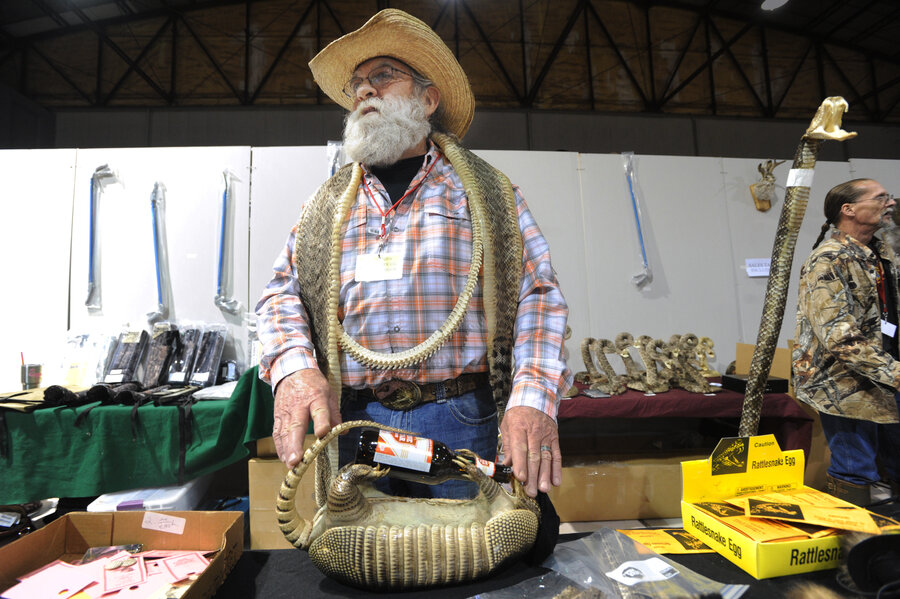Texas rattlesnake roundup: Why some people kill snakes for sport
Loading...
Each year in Sweetwater, Texas, over 30,000 visitors come to the rural town from near and far to see thousands of rattlesnakes.
Led by the city’s Junior Chamber of Commerce, referred to as the "Jaycees," Sweetwater’s annual “World’s Largest Rattlesnake Roundup,” ends Sunday. At the roundup, fans watch the rattlesnakes slither together in a pit before handlers behead and skin the animals. And it’s not all watching: Visitors can participate by skinning the animals and making handprints on a wall with the snakes’ blood.
The Jaycees say the event is necessary to curb overpopulation, protect human safety, and keep local livestock alive.
According to the Center for Disease Control, 7,000 to 8,000 people are bitten by venomous snakes – including rattlesnakes, copperheads, coral snakes, and cottonmouths – each year in the US, and about five of these people die.
David Steen, an amphibian and reptiles biologist at Auburn University, tells The Washington Post that rattlesnakes typically bite only those who deliberately interfere with the snakes, such as professional exterminators and drunk people. Thus, the "human safety" argument is baseless.
“If you don’t do any of those things, the risks of getting bitten by a snake are really low,” says Steen. “What does a snake have to gain by attacking you? It’s not going to try to eat you. If we respect their place in the environment and also respect their space, then I think we can live alongside them with no problem at all."
And according to The Washington Post, the US Department of Agriculture didn’t record any rattlesnake-induced cattle deaths last year.
But advocates also say the roundup is a tradition – and a profitable one.
Last year’s event brought in almost $8.4 million to Sweetwater, report the Jaycees. Over 100 full time jobs were created for the event, and all sectors of the local economy appreciate the event’s business. Over $3.2 million was brought into local lodging establishments and almost $5 million was brought into local restaurants and retail shops.
If the roundup were banned, “It would be a devastating blow to us,” snake handler David Sager told the New York Times in 2014. “The rattlesnake roundup is our ways and means.”
The Jaycees note that the snakes’ deaths are not in vain: Their meat is eaten and their skin and venom are sold.
And the money is always put to good use, say roundup proponents. As a nonprofit group, the Sweetwater Jaycees use the event’s revenue to feed local families on Thanksgiving, finance local development projects, and help local students.
“I love it and my family absolutely loves it,” commented one visitor in the Jaycee’s 2015 report. “It’s been around for many years and can remember my grandparents taking us as kids, it’s nice to carry on the tradition with my own kids!”
And the ecosystems are not in danger, say rattlesnake hunters. They say after years of rattlesnake round-ups, the population is as viable as ever.
“We’re not cutting the population any,” Jaycee spokesman Rob McCann tells the Midland paper. “I’ve been hunting the same dens for 25 years – the exact same dens. I get from 10 to 20 every year from the same dens.”
But conservations refute the overpopulation argument as well.
“Like other wild animals with natural predators, snake populations are maintained by prey abundance (rodents) and levels of predation and disease,” Melissa Amarello, co-founder of Advocates for Snake Preservation, writes for National Geographic. “Biologists and conservationists believe that roundups have contributed to the current decline in eastern diamondback rattlesnakes, which have been proposed for listing under the Endangered Species Act.”
But cities like Claxton, Georgia, suggest a third way that may appease both rattlesnake handlers and animal rights advocates. Since 2012, Claxton’s rattlesnake roundup has involved no killing. Instead, handlers teach visitors about snake safety while rattlesnakes are available for viewing.
National Geographic says Claxton’s revised roundup is as popular and profitable as ever.
“We recognize that these festivals happen in small towns,” Amarella, tells the El Paso Herald Post. “It’s a really important source of revenue for the local economy. It’s part of their culture and their tradition, and we don’t want to take all that away from them. We just want them to stop killing snakes at the roundup.”








